
Scent hounds are a type of hound that primarily hunts by scent rather than sight. These breeds are hunting dogs and are generally regarded as having some of the most sensitive noses among dogs. Scent hounds specialize in following scent or smells. Most of them tend to have long, drooping ears and large nasal cavities to enhance smell sensitivity. They need to have relatively high endurance to be able to keep track of scent over long distances and rough terrain. It is believed that they were first bred by the Celts by crossbreeding mastiff-type dogs with sighthounds. The first established scent hounds were St. Hubert Hounds bred by monks in Belgium during the Middle Ages.

The Alpine Dachsbracke is a small breed of dog of the scent hound type originating in Austria. The Alpine Dachsbracke was bred to track wounded deer as well as boar, hare, and fox. It is highly efficient at following a trail even after it has gone cold. The Alpine Dachsbracke is very sturdy.

The Hamiltonstövare is a breed of scenthound originally developed by the founder of the Swedish Kennel Club, Count Adolf Hamilton. Its ancestors include several German hounds as well as English Foxhounds and Harriers. The breed is recognized by the Swedish Kennel Club, Federation Cynologique Internationale (FCI) and the American Kennel Club's Foundational Stock Service.
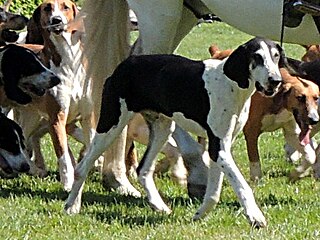
The Chien Français Blanc et Noir is a breed of dog of the scenthound type, originating in France. The breed is used for hunting in packs and descends from the old Hound of Saintonge type of large hunting dog.
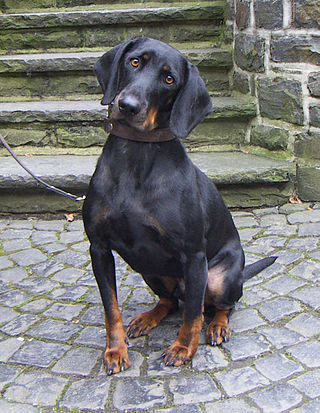
The Austrian Black and Tan Hound is a medium sized scenthound originating in Austria and is used for tracking wounded game, most commonly hare, in high altitudes.
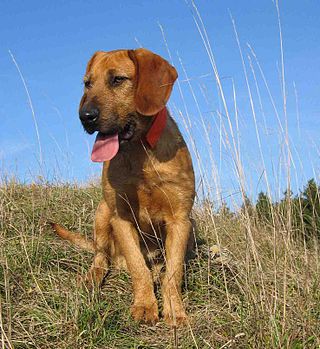
The Styrian Coarse-haired Hound is a breed of medium-sized hound dog originated in the Austrian province of Styria. It is bred as a scenthound, for hunting boar in mountainous terrain. The breed is one of the large Austrian Bracke.

The Barak or Bosnian Broken-haired Hound, is a hunting dog breed developed in Bosnia. The breed is a scenthound, originally used to hunt large game. Other names include Bosnian Rough-haired Hound and Bosnian Rough-coated Hound. These names refer to the texture of the shaggy coat, usually called broken-haired or hard in English dog fancier jargon.

The Grand Anglo-Francais Tricolore is a breed of dog used in hunting as a scenthound, usually in packs. It is one of the Anglo-French hound breeds which were created by crossing French scenthounds with English (Anglo) Foxhounds.
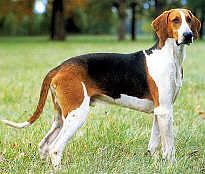
The Anglo-Français de Petite Vénerie is a medium-sized breed of dog used in hunting as a scenthound, usually in packs. It is one of the Anglo-French hound breeds which were created by crossing French scenthounds with English foxhounds. The name Petite Vénerie does not mean that dogs of the breed are petite or small, but rather that it is used to hunt small game.

The Transylvanian Hound, also known as the Transylvanian Scent Hound or Hungarian Hound, is a Hungarian breed of scent hound used primarily for hunting. It originated in the former Kingdom of Hungary in the historical region of Transylvania, which is now part of Romania. It is strong and of medium size, characterized by a black body with tan and sometimes white markings on the muzzle, chest and extremities, and distinctive tan eyebrow spots. It has a high-pitched bark for a dog of its size. The breed was rescued from extinction by focused breeding efforts in the late twentieth century. There were formerly two varieties, the tall and the short, developed for different kinds of hunting in the Middle Ages. Only the tall variety survives today.

The Finnish Hound is a breed of dog originally bred for hunting hare and fox.

The Westphalian Dachsbracke is a small, short-legged scenthound, a breed of dog originating in Westphalia, a region of Germany. The Westphalian Dachsbracke was used in Sweden to develop the Drever.

The Basset Artésien Normand is a short legged hound type dog developed in France. The word basset refers to short-legged hounds.

The Slovenský kopov is a medium-sized breed of hunting dog of the scenthound type. The breed originated in Slovakia, in Central Europe, and is bred for deer tracking and boar hunting. The name Black Forest Hound seems to have been created in North America for marketing purposes, since the breed has no connection with the Black Forest. The German name for this breed is Schwarzwildbracke which translates to Wild Boar Hound and not Schwarzwaldbracke which would be Black Forest Hound.

The Grand Anglo-Français Blanc et Noir translated into English as the Great Anglo-French White and Black Hound, is a breed of dog used in hunting as a scenthound, usually in packs. It is one of the Anglo-French hound breeds which were created by crossing French scenthounds with English (Anglo) Foxhounds.

The Grand Anglo-Français Blanc et Orange translated into English as the Great Anglo-French White and Orange Hound, is a breed of dog used in hunting as a scenthound, usually in packs. It is one of the Anglo-French hound breeds which were created by crossing French scenthounds with English (Anglo) foxhounds.

The Sabueso Español or Spanish Hound is a scenthound breed with its origin in the far north of Iberian Peninsula. This breed has been used in this mountainous region since hundreds of years ago for all kind of game: wild boar, hare, brown bear, wolf, red deer, fox, roe deer and chamois. It is an exclusive working breed, employed in hunting with firearms.
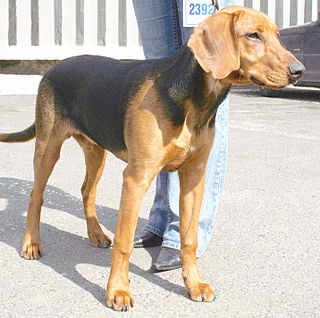
The Schillerstövare, translated as the Schiller Hound in English, is a breed of dog of the scenthound type, originating as a hunting dog in Sweden in the late 19th century.
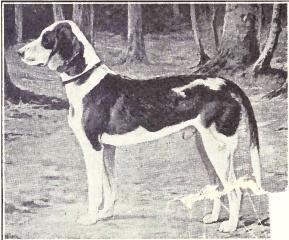
The German Hound is a breed of dog originating in Westphalia, a region of Germany. The German Hound is of the scenthound type, used for hunting both large and small game.

Bassets are a sub-type of scenthound deliberately bred with short legs, that are used for hunting where the hunters accompany the hunting hounds on foot.



















